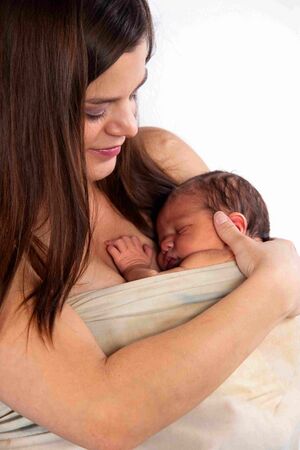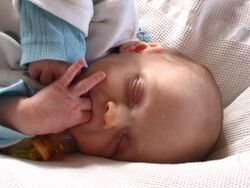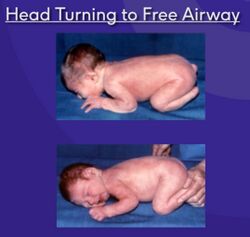Understanding Newborn Behaviour: Difference between revisions
(Neonatal Behavioral Assessment Scale) |
(added videos) |
||
| Line 20: | Line 20: | ||
== Three Newborn Survival Behaviours Which Build on Foetal Action Patterns == | == Three Newborn Survival Behaviours Which Build on Foetal Action Patterns == | ||
These newborn survival behaviours include rooting, the suck-swallow-breathe synergy, and turning the head to free the airway.<ref name=":0" /> These movement behaviours are organised as perceptual-motor synergies (also referred to as motor patterns) which can be adapted to changing circumstances and events in the environment.<ref name=":0" /> Previously these synergies were described as reflexes, but more recent studies have shown that these synergies involve complex patterns of movements adapted to ongoing changes in the environment. <ref name=":1" /><ref name=":0" /> | These newborn survival behaviours include rooting, the suck-swallow-breathe synergy, and turning the head to free the airway.<ref name=":0" /> These movement behaviours are organised as perceptual-motor synergies (also referred to as motor patterns) which can be adapted to changing circumstances and events in the environment.<ref name=":0" /> Previously these synergies were described as reflexes, but more recent studies have shown that these synergies involve complex patterns of movements adapted to ongoing changes in the environment. <ref name=":1" /><ref name=":0" /> | ||
==='''Rooting'''=== | ==='''Rooting'''=== | ||
| Line 54: | Line 55: | ||
Or you can watch these short videos to get a better understanding. The third video shows the full NBAS exam. It is in French, but even if you do not understand French, the demonstration gives you a good overview of the full exam. | Or you can watch these short videos to get a better understanding. The third video shows the full NBAS exam. It is in French, but even if you do not understand French, the demonstration gives you a good overview of the full exam. | ||
<div class="row"> | |||
<div class="col-md-4"> {{#ev:youtube|tqc8gKuXs3s|250}} <div class="text-right"><ref>Treeincement.The Brazelton Neonatal Assessment. Available from: https://youtu.be/tqc8gKuXs3s [last accessed 13/05/2022]</ref></div></div> | |||
<div class="col-md-4"> {{#ev:youtube|ZisX_F6HAfE|250}} <div class="text-right"><ref>FWIChannel. Brazelton Presentation. Available from: https://youtu.be/ZisX_F6HAfE [last accessed 13/05/2022]</ref></div></div> | |||
<div class="col-md-4"> {{#ev:youtube|9GnUt1XJ0vs|250}} <div class="text-right"><ref>Les petits princes de l'éveil .Elisebenazet. Petit aperçu d'une échelle de Brazelton - Elise Bénazet. Available from: https://youtu.be/9GnUt1XJ0vs [last accessed 13/05/2022]</ref></div></div> | |||
</div> | |||
=== Tired === | === Tired === | ||
Revision as of 00:36, 14 May 2022
Top Contributors - Robin Tacchetti, Robin Leigh Tacchetti, Tarina van der Stockt, Ewa Jaraczewska, Kim Jackson, Jess Bell and Tony Lowe
Introduction[edit | edit source]
Newborns are born with an innate capacity to interact with their environment.[1] Instinctive cognitive and sensorimotor behaviour contribute to survival and social bonding.[2] Infants naturally find ways to use touch, manage arousal levels, self-soothe and adapt to their new physical environment. In addition to adaptation, they signal their needs with different cries and temperaments.[1]
Adapting to the Environment[edit | edit source]
One of the most effective ways for an infant to adapt to their environment is through skin-to-skin (SSC) contact. The baby dressed in a diaper is placed on the mother’s bare chest so that frontal body contact is skin-to-skin. (baby on their mother’s chest).[3] UNICEF outlines the many benefits for mother-infant skin-to-skin contact:[4]
- Calms and relaxes both mother and infant
- Regulates the infant’s heart rate and breathing, helping them to better adapt to life outside the womb
- Stimulates digestion and interest in feeding
- Regulates temperature
- Enables colonisation of the infant’s skin with the mother’s friendly bacteria, thus providing protection against infection
- Stimulates the release of hormones to support breastfeeding and mothering[4]
Research shows skin-to-skin contact may have secondary benefits for the mother in terms of her long-term mental health, in addition to its positive impact on infant development. [5][6]
Three Newborn Survival Behaviours Which Build on Foetal Action Patterns[edit | edit source]
These newborn survival behaviours include rooting, the suck-swallow-breathe synergy, and turning the head to free the airway.[1] These movement behaviours are organised as perceptual-motor synergies (also referred to as motor patterns) which can be adapted to changing circumstances and events in the environment.[1] Previously these synergies were described as reflexes, but more recent studies have shown that these synergies involve complex patterns of movements adapted to ongoing changes in the environment. [2][1]
Rooting[edit | edit source]
- Rooting refers to the infant's tendency to turn their head towards a touch stimulus, applied to the area around the mouth which facilitates turning towards and latching onto the nipple for feeding.
- Traditionally rooting was considered to be a stereotype response to a specific stimulus in other words, it was thought to be a simple reflex. But research has shown that the rooting response adapts to circumstances, for instance, rooting is not elicited when babies or infants touch themselves. [1]
- The motion of the infant's head and mouth occurs simultaneously with whole-body movements suggesting rooting is more than a reflex.[2][7]
Sucking[edit | edit source]
- Sucking is another newborn behaviour that involves a complex interaction of muscle contractions that are adaptable to the environment. Babies adjust sucking pressure based on the flow of milk by sensing the upcoming flow. Studies show that newborns adjust the sucking pressure in a precise and anticipatory way demonstrating action vs reflex.[2] “Craig and Lee (1999) found that neonates adjusted their sucking action in a precise and prospective way indicating that they anticipated the upcoming flow of milk.” [2]
- Sucking has two phases
- creating a temporary vacuum in the mouth region
- releasing the milk from the nipple[8]
- Sucking adaptation can also be seen when newborns suck for comfort instead of food.[9]
Head turning to keep airway clear[edit | edit source]
- The ability to lift and turn head to keep airway clear is another perceptual-motor synergy present from birth. [1]
- When placed face-down on a supporting surface newborn infants will lift and turn their heads to clear the airway. [1]
- Lifting and turning the head involves not only the neck muscles, but also requires some adjustments in the upper extremities and trunk muscles to provide some stability to support the neck movements.[8]
Arousal, Crying and Colic[edit | edit source]
Neonatal Behavioral Assessment Scale[edit | edit source]
Pam Versfeld refers to this assessment scale throughout her course on Newborn Infant Behaviour. Dr T Berry Brazelton along with colleagues at Harvard University has studied infant behaviour over many decades and developed the widely used Neonatal Behavioral Assessment Scale (NBAS).
You can read more about it here by following these links:
Or you can watch these short videos to get a better understanding. The third video shows the full NBAS exam. It is in French, but even if you do not understand French, the demonstration gives you a good overview of the full exam.
Tired[edit | edit source]
- Yawns
- Fusses
- Loses interest in people or toys
- Stares into the distance
- Jerky movements
- Sucks fingers
Hungry[edit | edit source]
- Head turns towards breast
- Makes sucking noises
Play[edit | edit source]
- Smiles
- Hands reaching towards you
- Eyes wide and bright
- Makes eye contact with you
- Smooth movements
Needs a Break[edit | edit source]
- Squirms
- Kicks
- Turns head away from you
Infant Temperament[edit | edit source]
Newborn temperament describes the way in which babies respond and react to stimulation. Their emotions and reactions are a result of nature (innate personality) and nurture (parenting style). Researchers Thomas and Chess reported that when a child's personality is well suited to their environment, they will do better than children whose personalities and environments fit together poorly.[14] Personality traits can be grouped into the following nine categories:[1]
- Activity level: how active the infant is
- Rhythmicity: how regular the infant’s sleep/wake and feeding routines are
- Distractibility: how easily the infant can be distracted from something they are doing
- Approach/withdrawal: how the infant responds to new experiences
- Adaptability: how the infant adapts to new situations
- Attention span/persistence: how persistent the infant is when faced with challenges
- Intensity of reaction: how intense the infant’s responses and emotions are
- Sensitivity: how sensitive the infant is to flavours, textures, and noises
- Quality of mood: whether the infant has a happy, positive mood most of the time or an unpleasant, negative mood most of the time [1]
Based on these personality traits, Thomas and Chess[14] then divided babies into three temperament categories.
- Easy or flexible: adaptable, not easily upset, happy, regular sleep and eating patterns
- Active or feisty: fearful of new people or situations, easily upset by stimulation or noise, fussy, intense in reactions
- Slow to warm or cautious: withdraw or react negatively to new situations, but over time become more positive with repeated exposure, less active
Not all babies fit into one of the described temperament categories. Based on the research, 40% of babies are easy, 10% are active, and 15% are slow to warm. The basic temperament trait remains the same over time, but the intensity to the trait may change.[15]
Infant States of Arousal[edit | edit source]
Throughout the day, an infant will cycle through several stages of arousal, some quick, others slow. American paediatrician Dr T.B. Brazelton identified six states of infant behaviour. Healthchildren.org[16] describes Dr Brazelton’s six stages of arousal:
- Deep Sleep State: Completely relaxed, unresponsive to outside noise, and breathing deeply.
- Active Sleep State: Rotating or fluttering of the eyes, shallow breathing, more receptive to outside noise.
- Drowsy State: State between alertness and sleepiness. Light stimulation, such as rocking them, can help ease them into sleep or slowly wake them up.
- Quiet Alert State: Ideal time for learning. They are happy, peaceful, and focused. Ready for stimulation and interaction.
- Active Alert State: Stretching, kicking, and rotating arms. Often referred to as a “fussy” period.
- Crying State: Flailing, screaming, kicking are all expressions of discomfort, such as hunger, boredom, loneliness, or tiredness. This is a time to soothe, provide resources, and a sense of safety.[16]
Understanding the baby’s temperament, as well as their arousal state is important for early intervention session planning.
Resources[edit | edit source]
- Brazelton Institute | Neonatal Behavioral Assessment Scale (NBAS)
- Brazelton Institute at Boston Children’s Hospital
- RaisingChildren | Baby cues and baby body language: a guide
- UNICEF | Skin-to-skin contact
References[edit | edit source]
- ↑ 1.0 1.1 1.2 1.3 1.4 1.5 1.6 1.7 1.8 1.9 Versfeld, P. Understanding Newborn Behaviour, Physioplus.2022
- ↑ 2.0 2.1 2.2 2.3 2.4 Von Hofsten C, Rosander K. The development of sensorimotor intelligence in infants. Advances in child development and behavior. 2018 Jan 1;55:73-106.
- ↑ Cleveland L, Hill CM, Pulse WS, DiCioccio HC, Field T, White-Traut R. Systematic review of skin-to-skin care for full-term, healthy newborns. Journal of Obstetric, Gynecologic & Neonatal Nursing. 2017 Nov 1;46(6):857-69.
- ↑ 4.0 4.1 Center for Perinatal Psychology. Six States of Alertness for Newborns. Available from:https://www.unicef.org.uk/babyfriendly/baby-friendly-resources/implementing-standards-resources/skin-to-skin-contact/ (March 28, 2016)
- ↑ Bigelow AE, Power M. Mother–Infant Skin-to-Skin Contact: Short‐and Long-Term Effects for Mothers and Their Children Born Full-Term. Frontiers in Psychology. 2020;11
- ↑ Cooijmans KH, Beijers R, Rovers AC, de Weerth C. Effectiveness of skin-to-skin contact versus care-as-usual in mothers and their full-term infants: study protocol for a parallel-group randomized controlled trial. BMC pediatrics. 2017 Dec;17(1):1-6.
- ↑ Rochat P, Hespos SJ. Differential rooting response by neonates: Evidence for an early sense of self. Infant and Child Development. 1997 Sep 1;6(3‐4):105-12.
- ↑ 8.0 8.1 Versfeld, P. SfA Infant Perceptual Motor Development.
- ↑ Lau C. Development of suck and swallow mechanisms in infants. Annals of Nutrition and Metabolism. 2015;66(Suppl. 5):7-14.
- ↑ Treeincement.The Brazelton Neonatal Assessment. Available from: https://youtu.be/tqc8gKuXs3s [last accessed 13/05/2022]
- ↑ FWIChannel. Brazelton Presentation. Available from: https://youtu.be/ZisX_F6HAfE [last accessed 13/05/2022]
- ↑ Les petits princes de l'éveil .Elisebenazet. Petit aperçu d'une échelle de Brazelton - Elise Bénazet. Available from: https://youtu.be/9GnUt1XJ0vs [last accessed 13/05/2022]
- ↑ 13.0 13.1 13.2 13.3 RaisingChildren.net.au. Baby Cues and Baby Body Language: A Guide. Available from:https://raisingchildren.net.au/newborns/connecting-communicating/communicating/baby-cues 8/20/20
- ↑ 14.0 14.1 McClowry SG, Rodriguez ET, Koslowitz R. Temperament-based intervention: Re-examining goodness of fit. International Journal of Developmental Science. 2008 Jan 1;2(1-2):120-35.
- ↑ Center for Social and Emotional Foundations for Learning. Understanding Temperaments in Infants and Toddlers. Available from:http://csefel.vanderbilt.edu/resources/wwb/wwb23.html 10/2010
- ↑ 16.0 16.1 Healthchildren.org. States of Consciousness in Newborns. Available from:https://www.healthychildren.org/English/ages-stages/baby/Pages/States-of-Consciousness-in-Newborns.aspx 11/2/2009










